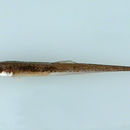Biology
provided by Arctic Ocean Biodiversity 2011
Subarctic poacher also found, but not commonly, in southern Chukchi Sea
- license
- cc-by-nc
- copyright
- Arctic Ocean Diversity
- author
- Kitty Mecklenburg
- author
- Tony Mecklenburg
Life Cycle
provided by Arctic Ocean Biodiversity 2011
Little is known; Spawn in late summer; Live to about 5 years
- license
- cc-by-nc
- copyright
- Arctic Ocean Diversity
- author
- Kitty Mecklenburg
- author
- Tony Mecklenburg
Trophic Strategy
provided by Arctic Ocean Biodiversity 2011
Feed predominantly on mysids, also euphausiids, copepods, other small epibenthic crustaceans; Eaten by flounders (Hippoglossus), great sculpin (Myoxocephalus polyacanthocephalus), other bottom fishes
- license
- cc-by-nc
- copyright
- Arctic Ocean Diversity
- author
- Kitty Mecklenburg
- author
- Tony Mecklenburg
Habitat
provided by Arctic Ocean Biodiversity 2011
Subarctic-arctic; Benthopelagic, above sand and gravel bottoms; Unlike most poachers, swims well above the bottom; Intertidal and subtidal to depth of about 128 m, frequently among eelgrass (Zostera), less commonly among algae (Laminaria); Abundant in sheltered bays during summer, descending deeper for winter
- license
- cc-by-nc
- copyright
- Arctic Ocean Diversity
- author
- Kitty Mecklenburg
- author
- Tony Mecklenburg
Comprehensive Description
provided by Arctic Ocean Biodiversity 2011
Dorsal part of body and head dark brown; Underside of head and anterior part of body white, sharply demarcated from dark dorsal part; Long, slender poacher with mouth at the end of a tubelike snout; Long, dark fleshy barbel on chin in Chukchi Sea and northern Bering Sea specimens
- license
- cc-by-nc
- copyright
- Arctic Ocean Diversity
- author
- Kitty Mecklenburg
- author
- Tony Mecklenburg
Diagnostic Description
provided by Fishbase
Caudal fin rounded (Ref. 28197). Preserved specimens dark brown, darker dorsally, paler ventrally (Ref. 28197). A stripe on head, from tip of snout to, through part between temporal ridge and uppermost preopercular spine, to posterior upper part of opercle (Ref. 28197). Fins pale, except for the dark caudal fin (Ref. 28197). Tiny spots on dorsal and pectoral fin rays (Ref. 28197).
Morphology
provided by Fishbase
Dorsal spines (total): 5 - 8; Dorsal soft rays (total): 6 - 9; Analspines: 0; Analsoft rays: 8 - 13
Trophic Strategy
provided by Fishbase
Always live in coastal shallows (50-70m) and experience sharp seasonal temperature variations ranging from 1.8-12°C (Ref. 41410).
Biology
provided by Fishbase
Inhabits intertidal areas and to 55 m depth, possibly to 128 m (Ref. 2850). Often found among eelgrasses or seaweeds (Ref. 2850).
Tubenose poacher
provided by wikipedia EN

Pallasina barbata in an aquarium
The tubenose poacher (Pallasina barbata) is a species of poacher native to the northern Pacific Ocean. This species occurs at depths of from 0 to 105 metres (0 to 344 ft). This species grows to a length of 17 centimetres (6.7 in) TL. This species is the only known member of its genus.
References

- license
- cc-by-sa-3.0
- copyright
- Wikipedia authors and editors
Tubenose poacher: Brief Summary
provided by wikipedia EN

Pallasina barbata in an aquarium
The tubenose poacher (Pallasina barbata) is a species of poacher native to the northern Pacific Ocean. This species occurs at depths of from 0 to 105 metres (0 to 344 ft). This species grows to a length of 17 centimetres (6.7 in) TL. This species is the only known member of its genus.
- license
- cc-by-sa-3.0
- copyright
- Wikipedia authors and editors


 Pallasina barbata in an aquarium
Pallasina barbata in an aquarium